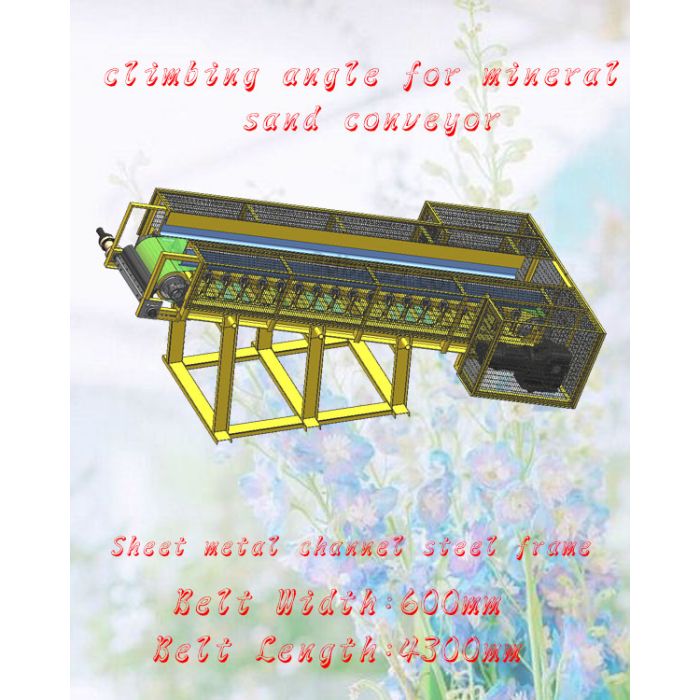beltconveyor_w600_l4300
- Stp samples download
- click to down
试用数据点击上方下载!
The suitable range of climbing angle for mineral sand conveyor is usually between 0 ° and 30 °, but the specific value depends on various factors. The following is a detailed analysis of this issue:
1、 Material characteristics
Density and particle size: The density and particle size of mineral sand are key factors affecting the climbing angle. Mineral sands with lower density and smaller particle size can use larger climbing angles, while mineral sands with higher density and larger particle size require smaller climbing angles to ensure smooth transportation.
Liquidity and friction characteristics: Mineral sands that are easy to flow and have good lubricity can be used at larger climbing angles. On the contrary, if the viscosity or adhesion of the mineral sand is strong, a smaller climbing angle needs to be selected.
2、 Transportation requirements
Conveying capacity: A larger climbing angle may reduce the conveying capacity of the conveyor, as materials need to overcome greater gravity effects when climbing. Therefore, in situations where high conveying capacity is required, a smaller climbing angle should be chosen.
Occupation area: If a larger lifting height needs to be achieved within a smaller occupation area, it is possible to consider increasing the climbing angle appropriately, but it needs to be done on the premise of ensuring conveying efficiency and equipment stability.
3、 Equipment factors
Structural strength: Larger climbing angles may require a more powerful drive system and stronger conveyor belts or chains to ensure the stability and reliability of the equipment. Therefore, when choosing the climbing angle, it is necessary to comprehensively consider the structural strength of the equipment.
Material selection: The material selection of the conveyor also affects the choice of climbing angle. For example, belt materials with high strength and wear resistance can withstand the wear and tension caused by larger climbing angles.
4、 Operating environment
The operating environment of the conveyor also affects the selection of the climbing angle. For example, in harsh environments such as high temperature and high humidity, the performance and material selection of conveyors may be limited, so careful selection of climbing angles is necessary.
5、 Special angle
Sometimes, according to specific requirements, the climbing angle of a climbing belt conveyor may exceed 30 °, and even reach 45 ° or above or close to 90 ° vertical lifting. But this situation usually requires special consideration and optimization in equipment design, material selection, drive system, and other aspects.
In summary, the climbing angle of the mineral sand conveyor needs to be comprehensively considered and determined based on various factors such as material characteristics, conveying requirements, equipment factors, and operating environment. In practical applications, the optimal climbing angle can be determined through experiments or engineering calculations to ensure the normal operation and optimal performance of the conveyor.
矿砂输送机的爬升角度合适范围通常在0°到30°之间,但具体数值取决于多种因素,以下是对这一问题的详细分析:
一、物料特性
- 密度与颗粒度:矿砂的密度和颗粒度是影响爬升角度的关键因素。密度较小、颗粒度较小的矿砂可以使用较大的爬坡角度,而密度大、颗粒度大的矿砂则需要较小的爬坡角度以确保顺利输送。
- 流动性与摩擦特性:易流动和具有良好润滑性的矿砂可以使用较大的爬坡角度。相反,如果矿砂的粘稠性或黏附性较强,则需要选择较小的爬坡角度。
二、输送要求
- 输送能力:较大的爬坡角度可能会降低输送机的输送能力,因为物料在爬坡时需要克服更大的重力影响。因此,在需要高输送能力的场合,应选择较小的爬坡角度。
- 占地面积:如果需要在较小的占地面积内实现较大的提升高度,可以考虑适当增加爬坡角度,但需在确保输送效率和设备稳定性的前提下进行。
三、设备因素
- 结构强度:较大的爬坡角度可能需要更强大的驱动系统和更坚固的输送带或链条,以确保设备的稳定性和可靠性。因此,在选择爬坡角度时,需要综合考虑设备的结构强度。
- 材料选择:输送机的材料选择也会影响爬坡角度的选择。例如,高强度、高耐磨性的皮带材质可以承受更大的爬坡角度带来的磨损和张力。
四、运行环境
输送机的运行环境也会对爬坡角度的选择产生影响。例如,在高温、高湿等恶劣环境下,输送机的性能和材料选择可能会受到限制,因此需要谨慎选择爬坡角度。
五、特殊角度
有时根据特定的需求,爬坡皮带输送机的爬坡角度可能会超过30°,甚至达到45°以上或接近90°垂直提升。但这种情况通常需要在设备设计、材料选择、驱动系统等方面进行特殊考虑和优化。
综上所述,矿砂输送机的爬升角度需要根据物料特性、输送要求、设备因素和运行环境等多种因素进行综合考虑和确定。在实际应用中,可以通过试验或进行工程计算来确定最佳的爬坡角度,以确保输送机的正常运行和最佳性能。

